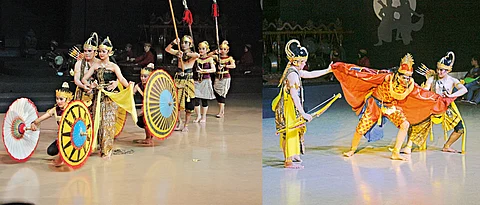

One constant feature of all the Indonesian cities that we have travelled in is that every evening they have a Rama and Shinta (Sita) show. So on the second day of our stay in Yogyakarta (pronounced as Jogjakarta) we were taken to watch Ramayana Ballet show in The Prambanan Temple complex.
A few minutes away from the auditorium, we met the artistes who play Prabhu Ram, Shinta Dewi and Hanoman. On seeing them, the camera happy tourists went on a photo clicking spree. We tried to strike a conversation with the lady who played Shinta. Unfortunately, she didn’t speak English and with the help of our tourist guide, Yanni, we learnt that she has been playing the goddess’ role for 17 years now.
Inside the auditorium, a complete Indonesian opera sets the tone — with two women vocalists and men and women playing the traditional instruments, one which we could identify as a gong. The costumes, the props, the dances and the set are all grand. The story is fairly reminiscent of the Doordarshan’s telecast of the epic in late 80s. Yes, the one in which Sita had to prove her purity. Now that we are reading many versions of the Ramayana and the Mahabharata and presentation of the stories from many different characters, this traditional plot-line didn’t go down well with us.
Especially, when Shinta doesn’t put up a whimper of protest when Prabhu Rahwana (Ravana) tries to abduct her.
Incidentally, there is another track in the story from the old DD show — about Dewi Tara, who is Sugriwa’s wife, but taken by force by Subali (we know him as Bali). Here again, Rama rescues Tara and hands her over to Sugriwa, without asking for her consent, or her thoughts on it.
Where the plot-line differs is reference of Sri Lanka as Alengka. Also, Rahwana’s niece Trijata is new to us. In the Argasoka garden (Ashok van), she is the one who is consoling Shinta and convinces Rahwana to leave her alone, when he is hellbent on killing her because she refuses to accept his marriage proposal.
The white monkey, Hanoman too has a popular role to play. In fact the locals await his entry with much glee. The way he jumps and prances around elicits much laughter from the audience comprising many local Muslims, South Asians and the Europeans.
Chakkechak..kechak
Our next tryst with the Ramayana was the Kechak Ramayana show on the Uluwatu beach in Bali. It is performed in an open air auditorium, surrounded by sea and the setting sun. The show began with the priest performing the puja. The deep mala (lamp) was lit and a faint noise in the background steadily grew louder. Fifty men with their bare upper bodies, and a flower tucked behind their ear, chant Chakkecha..kechak. Seated around the deep maal, the group takes up the chant, which can be heard right at the back, where we were seated. Their energy, their enthusiasm could be felt at a distance too. It’s no mean feat considering that they must be doing it every single evening of their lives.
Many Indians amongst the audience discussed the ancient ritual and dance trying to find commonalities in the epic that we know. The foreigners, however, exhibited palpable fear at the Lanka (Alengka) dahan sequence and left the place before the show ended.
